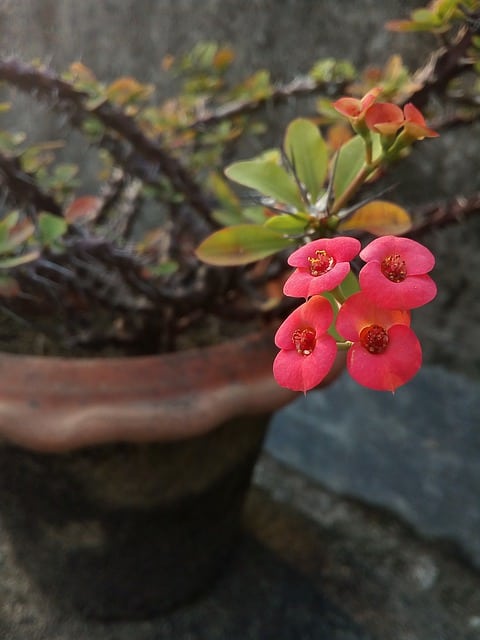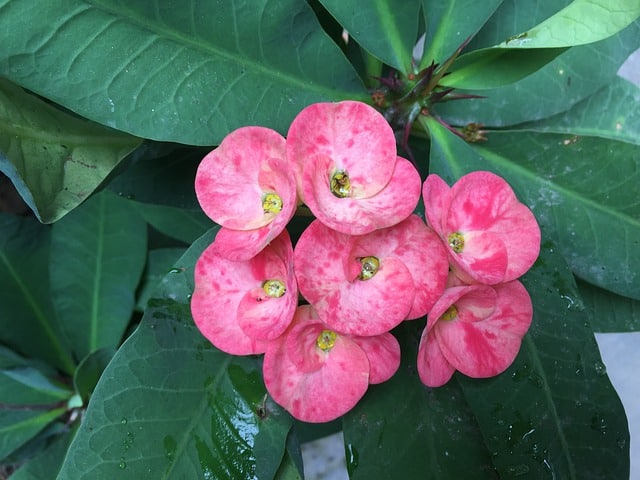Euphorbia mainly dies due to Stem rot which is caused by Fungi like Rhizoctoria and Fusaria. Euphorbia could also die due to corking. Euphorbia goes dormant in winter, people might mistake it to be dying.
Euphorbia is a group of plants belonging to the spurge family( Euphorbiaceae). The most famous of these plants is Euphorbia mili which is commonly called Crown of thorns, Christ plant, or Christ thorn.
The plant is kept for its beautiful flowers and unique appearance. Its appearance is likened to the crown that is worn by Jesus.
Usually, the plant may seem sick when it’s not taken care of well. Proper sunlight, warmth, and watering is needed for the plant to thrive.
Why has my Euphorbia gone brown?
Euphorbia stem turns brown in the cases of rotting, sunburn, and Corking. It also happens when the plant is pot-bound.
Corking in Euphorbia
Corking happens when the outer layer(epidermis) of the plant needs to be replaced. You will see browning of the old stems accompanied by tissue bulging in the area.
This is a natural process and you shouldn’t try to disturb it. There’s no treatment needed. The plant eventually makes up for the lost tissue/epidermis.
Corking on your plant may look unattractive but you need to wait out this phase.
Brown Spots in Euphorbia(Sunburn)
A sunburnt plant sees browning only on one side. Sunburn is seen when the plant is shifted suddenly to a new place with different external conditions.
Many people that write to me experience this issue. Sunburn in Euphorbia can be identified easily.
It may happen when there’s too much sun or when the plant doesn’t get enough water.
- The plants that are grown in greenhouses run into sunburn easily. They are grown in stable conditions in the greenhouse. When you put the plant out in the sun directly after buying, it will get burned in just a few hours.
- Try to acclimate the plant to your external conditions.
- Be careful when you move the crown of thorns plant to a new place. If the plant has been facing south for a while do not rotate it 180°, this will cause sunburn in a matter of hours.
- If the plant has been under the shade of shade cloth, do not shift it abruptly into full sun. Try to acclimate the plant slowly to new conditions.
Euphorbia Rotting
Stem rot is common in Euphorbia. It is caused by two types of fungi. Stem rot is seen when the plant is in humid and moist conditions.
Rhizoctonia
Rhizoctonia is a fungus that is found in all types of soils. This fungus attacks the crown of thorns plant when the soil moisture and humidity are high.
This fungus is seen on both roots and stems in more mature plants. In the beginning, plants look limp and unhealthy.
After a while, early lesions develop on the stem where the stem touches the ground. People often mistake this stage for a water-soaked plant.

As the disease progresses, brown or black lesions are developed on the entire stem.
Fusarium
Fusarium is another fungus that affects the crown of thorns plants. There are many strains of Fusarium.
This fungus attacks all parts of the plant. Plants develop wet, mushy, and sunken spots. These lesions are formed near the base of the stem and these lesions are surrounded by a purple border.
Cutting or pruning the infected parts doesn’t do much. Once the disease becomes severe, the lesions spread to the base of the stem, indicating the infection of the entire plant.
Prevention and Control
Controlling such pests is important especially as you can’t do much once the infection sets in.
Rhizoctonia is found in soils. It remains dormant until suitable conditions are present. It spreads from one pot to the other via soil or tools.
You can prevent Rhizoctonia infection by using a fresh growing medium and washing and sterilizing gardening tools and pots.
Avoid watering stem and leaves. Do not water often, water deeply.
Check the soil with fingers regularly. Only water if the soil is bone dry from the top to a finger depth.
Fusarium spreads through wounds and lesions. The best way to prevent a Fusarium infection is to destroy the infected plants thoroughly.
Why are my Euphorbia spines turning brown?
Some people mail me saying that their Euphorbia spines are turning brown. This usually happens as the plant ages.
It may also happen if the humus content in the soil is high. In this case, lower spines will turn brown. There’s not much to worry about in this case too.
Similar to this article: Pencil Cactus Dying
Why are the leaves on my crown of thorns turning yellow?
Euphorbia leaves shrivel and turn yellow due to underwatering. Fertilizer burn causes the foliage to turn yellow too.
Water only when needed. Watering once a week is ideal. A good rule of thumb is to water the plant when soil is dry up to an inch or two. You can check for moisture with your finger.
Euphorbia is a succulent. So, other factors also initiate the yellowing of leaves.
- The crown of thorns plant prefers high temperatures. Move them accordingly or shelter them when frost hits to avoid yellowing of the leaves.
- They grow in desert sands. So, it makes sense to use a potting mix that is good at draining excess water.
- Do not add fertilizer to the plant in winter.
Why is my Euphorbia dropping leaves?
Drought stress is the main reason why Euphorbia milli loses foliage. Water it deeply once a week to prevent dropping leaves.
Most people seem to think that succulents don’t like water. Any plant loves water. In the case of the Crown of Thorns plant, make sure that the potting mix has good drainage.
Don’t panic if your crown of thorns plant is dropping leaves, you can revive the plant.
Why crown of thorns leaves curling?
Crown of Thorns plant stores water in its stems. The leaves take in water whenever they need some.
When the plant is underwatered, the leaves get curled. When you see curled-up leaves, understand that your plant is thirsty.
Water the plant well, don’t let the rootball dry up. Water when the top inch or two of the soil goes dry.
Why is my Euphorbia milii not flowering?
Indoor crown of thorns plant needs abundant light, water, and warmth to bloom.
Many people get tempted to feed the plant with fertilizers like ‘bloom booster’. Don’t do that. Your plant is probably underwatered or overwatered.
Water only when the soil is dry up to an inch or two. Make sure the soil has good drainage. Check the soil with fingers for moisture.
Leaves of this plant droop when it needs water. Check for such signs and water accordingly and your Euphorbia milli will bloom for sure!
Tip: Give the plant abundant sunlight, as it is essential for blooming
Does euphorbia die in winter?
It doesn’t die in winter. It just goes dormant. The plant rests and reserves its resources during this dormant phase.
You just need to water the plant when it needs some. Check the soil with your fingers, if the soil is dry only up to an inch or two, then water it.
Your crown of thorns plant will become active again once the dormant phase is over. Just make sure the temperature isn’t below 55°F.
How do you save a dying crown of thorns plant?
Proper care is essential to keep your crown of thorns plant healthy and thriving. Try not to shock the plant by changing the environment abruptly.
Let’s see what kind of measures to take to grow a healthy Euphorbia milli.
How often should I water my Euphorbia?
The rule of thumb is to water the plant when an inch or two of the soil/potting mix goes dry. You need to use a potting mix that has good drainage.
There’s no fixed schedule you can follow. Your indoor conditions could be different from mine.
If the soil doesn’t have good drainage, it will lead to waterlogged conditions. If the roots are waterlogged, then they rot.
Does the crown of thorns need full sun?
I place my plant where the plant will receive at least 3-4 hours of direct sunlight. Place the plant accordingly in your house.
In winter the plant can be placed at a south or west-facing window. In general, once you place the plant at a particular place do not move it around.
If you move the plant even 180° you’ll see sunburns. So, keep that in mind before moving the plant.
That is how you care for a crown of thorns plant. Do not let the plant go out of hand. Care for it well and it will reward your house with aesthetics.
Happy Gardening 🙂

